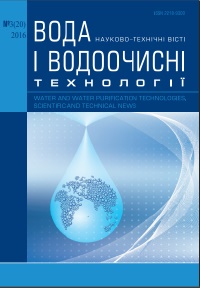CHARACTERIZATION OF SORPTION MATERIALS CONTAINING OXIDES OF MULTIVALENT METALS FOR USE IN PROCESSES OF LITHIUM EXTRACTION FROM SALT SOLUTIONS
DOI:
https://doi.org/10.20535/2218-93002032016122676Keywords:
lithium, composite materials, titanium dioxide, titanium-manganese sorbent, ion applicationAbstract
Since lithium is one of the most popular materials for the electronics industry, it is of interest to consider alternative sources of its receipt. The article analyzes the main sources of lithium production, global stocks and the dynamics of its production. We have considered the possibility of obtaining lithium from sea water by sorption method. The comparative characteristic of sorption materials based on the multivalent metal oxides was conducted, their structure parameters were determined. By method of X-ray analysis structure of the sorbents was studied. It is shown that the titanium-manganese sorbent is composite material consisting of particles of TiO2, rutile coated with amorphous MnO2. By electron paramagnetic resonance method valence states of manganese component in the sorbent structure were set. Adsorption isotherms from lithium solutions simulating sea water were obtained. The effect of modification of sorption materials by ion application was studied. It is shown that the highest sorption capacity to Li+ ions corresponds to titanium-manganese sorbent.References
The Economics of Lithium, Roskill Market Reports, 11th Edition, 2009.
Ober, Joyce A. Lithium (PDF). United States Geological Survey. P. 77—78. http://minerals.usgs.gov/minerals/pubs/commodity/lithium/450798.pdf. Retrieved 19 August 2007.
Volegžanina I.S. Mirovoj rynok litiâ i ego soedinenij // Marketing v Rossii i za rubežom, 2006, №5, P. 12—19.
Hanna Vikström, Simon Davidsson, Mikael Höök Lithium availability and future production outlooks // Applied Energy, 2013, Volume 110, P. 252—266. doi: 10.1016/j.apenergy.2013.04.005
Ashish Kumar Mishra and S. Ramaprabhu Removal of metals from aqueous solution and sea water by functionalized graphite nanoplatelets based electrodes // Journal of Hazardous Materials, 2011, Volume 185, Issue 1, P. 322—328. doi: 10.1016/j.jhazmat.2010.09.037
Stéphane Blain, Pierre Appriou and Henri Handel Preconcentration of trace metals from sea water with the chelating resin Chelamine // Analytica Chimica Acta, 1993, Volume 272, Issue 1, P. 91—97. doi: 10.1016/0003-2670(93)80379-Y
JP3026334 (A) Onodera Yoshiro et al. Recovery agent of lithium and its production (1991).
GB2264490 (A) Bristowe John Douglas. Recovery of heavy metals from water (1993).
WO2006072122 (A2) Raman Ahilan. Process for conversion of high pressure sea water reverse osmosis concentrate discharge (hpswro) from seawater desalination plants into magnesium chloride (for recovery of magnesium metal by electrolysis) and sodium chloride and hydrogen with cogener (2006).
Dieter Eckhartt Nuclear fuels for low-beta fusion reactors: Lithium resources revisited // Journal of Fusion Energy, 1995, Volume 14, Number 4, P. 329—341. doi: 10.1007/BF02214511
Julien Lemaire, Lenka Svecova, Fanny Lagallarde, Richard Laucournet, Pierre-Xavier Thivel Lithium recovery from aqueous solution by sorption/desorption // Hydrometallurgy, 2014, Volume 143, P. 1—11. doi: 10.1016/j.hydromet.2013.11.006
L. A. Šelkovnikova, S. I. Kargov, O. T. Gavlina, V. A. Ivanov, G. N. Altšuler Selektivnost’ ionoobmennikov dlâ izvlečeniâ ceziâ i rubidiâ iz ŝeločnyh rastvorov // Žurnal fizičeskoj himii, 2013, Volume 87, Number 1, P. 112—116.doi: 10.7868/S0044453713010263
Myoung Jun Park, Grace M. Nisola, Arnel B. Beltran, Rey Eliseo C. Torrejos, Jeong Gil Seo, Seong-Poong Lee, Hern Kim, Wook-Jin Chung Recyclable composite nanofiber adsorbent for Li+ recovery from seawater desalination retentate // Chemical Engineering Journal, 2014, Volume 254, P. 73—81. doi: 10.1016/j.cej.2014.05.095
Yosep Han, Hyunjung Kim, Jaikoo Park Millimeter-sized spherical ion-sieve foams with hierarchical pore structure for recovery of lithium from seawater // Chemical Engineering Journal, 2012, Volume 210, P. 482—489. doi: 10.1016/j.cej.2012.09.019
Xi-chang SHI, Zhi-bing ZHANG, Ding-fang ZHOU, Li-fen ZHANG, Bai-zhen CHEN, Liang-liang YU Synthesis of Li+ adsorbent (H2TiO3) and its adsorption properties // Transactions of Nonferrous Metals Society of China, 2013, Volume 23, Issue 1, P. 253—259. doi: 10.1016/S1003-6326(13)62453-X
Ramesh Chitrakar, Yoji Makita, Kenta Ooi and Akinari Sonoda Lithium recovery from salt lake brine by H2TiO3 // Dalton Transactions, 2014, Volume 43, P. 8933—8939. doi: 10.1039/C4DT00467A
Published
How to Cite
Issue
Section
License
Copyright (c) 2020 M. A. Chaban, A. V. Pal’chik, L. M. Rozhdestvenskaya, S. L. Vasilyuk, V. M. Linkov

This work is licensed under a Creative Commons Attribution-NonCommercial 4.0 International License.
The ownership of copyright remains with the Authors.
Authors may use their own material in other publications provided that the Journal is acknowledged as the original place of publication and National Technical University of Ukraine “Igor Sikorsky Kyiv Polytechnic Institute” as the Publisher.
Authors are reminded that it is their responsibility to comply with copyright laws. It is essential to ensure that no part of the text or illustrations have appeared or are due to appear in other publications, without prior permission from the copyright holder.
WPT articles are published under Creative Commons licence:
- Authors retain copyright and grant the journal right of first publication with the work simultaneously licensed under CC BY-NC 4.0 that allows others to share the work with an acknowledgement of the work's authorship and initial publication in this journal. The use of the material for commercial purposes is not permitted.
- Authors are able to enter into separate, additional contractual arrangements for the non-exclusive distribution of the journal's published version of the work (e.g., post it to an institutional repository or publish it in a book), with an acknowledgement of its initial publication in this journal.
- Authors are permitted and encouraged to post their work online (e.g., in institutional repositories or on their website) prior to and during the submission process, as it can lead to productive exchanges, as well as earlier and greater citation of published work.

